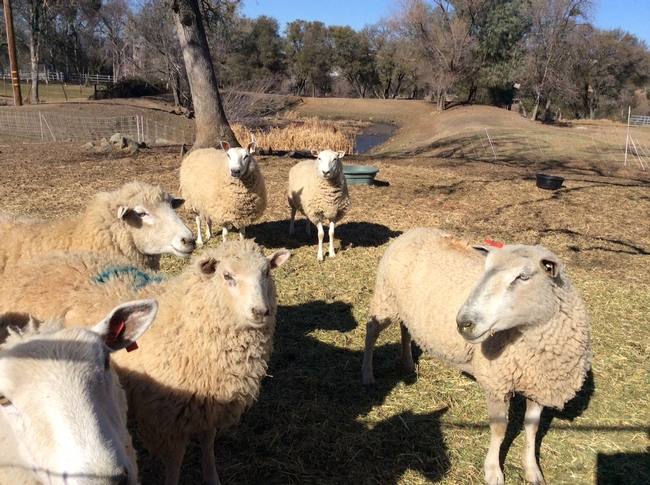
The local outlook, while serious, is not quite so bleak. The irrigation districts that serve most of the farms in Placer and Nevada Counties (the Nevada Irrigation District and the Placer County Water Agency) have asked customers to voluntarily cut back on water use by 15 percent. Both agencies have indicated that they will be monitoring water use during the course of the summer – if customers haven't reduced water usage voluntarily, the irrigation season may end early (sometime in September, most likely – rather than the normal end date of October 15).
So what does all of this mean for local farmers – and local eaters? Those of us with grazing livestock have already felt the impact - we've sold animals or purchased hay. Most small-scale vegetable and fruit growers will probably be able to get by during this growing season. Late summer will be the critical period – if July and August are exceptionally warm, a voluntary 15 percent reduction will be difficult to achieve. If non-farm users of irrigation water don't cut back on their water use, the 15 percent reduction will be difficult to achieve. An early end to the irrigation season could impact the availability of fall and winter vegetables especially. Since fruit trees generally set their fruiting buds during the summer prior to the next year's bloom, the impacts of this summer's drought may not be evident until next summer. Severe drought stress could impact tree fruit production for several years – we'll have to wait and see. Those of us who enjoy local food may notice higher prices for our favorite fruits and vegetables at the farmers' markets and at places like the BriarPatch and Newcastle Produce – due simply to the laws of supply and demand.
What can we do about the drought? Worrying about the weather won't make it rain – believe me, I've tried it! We can save water, however, whether we're farmers or not! At Flying Mule Farm, we've installed equipment on one of our leased properties that will allow us to more carefully monitor soil moisture. This will allow us to irrigate only when the plants need water. The same principle applies to watering landscaping and vegetable gardens – we can all be more judicious in the way we use water outdoors. Here are a few tips we recently compiled for an event at Bell Hill Elementary in Grass Valley:
In Your Home
- Use only a full dishwasher and clothes washer – don't wash partial loads.
- Don't let the water run when washing, brushing your teeth or shaving – turn it off and on as needed.
- Take showers instead of baths – a 10 minute shower with a low-flow showerhead uses half the water of a regular bath.
- If your shower takes a while to warm up, place buckets in the shower to use for watering plants. Do the same for the kitchen faucet.
- Test for a leaking toilet by adding food coloring to the tank (not the bowl). Without flushing, note if any color appears in the bowl after 30 minutes.
- Avoid flushing the toilet unnecessarily – don't use water for garbage! Dispose of tissues, insects and similar waste in the trash rather than the toilet.
- Save the water from steaming or boiling vegetables for house plants, vegetable broth for soup, or stir-fry liquid.
- Use the sink basin or a wash tub for hand-washing dishes instead of free-flowing tap water.
In Your Yard and Garden
- Apply mulch to your garden and flower beds. A 3-4” layer of mulch can reduce watering needs by as much as 50 percent. Grass clippings, dry leaves, pine needles, straw and shredded bark can be used as mulch.
- The best time to water your garden is in the late evening and early morning. Lower temperatures and limited wind will reduce water evaporation rates.
- Install a drip irrigation system. Drip irrigation is much more efficient than overhead watering with sprinklers.
- Control weeds! Weeds compete with vegetable and landscaping plants for water.
- Consider drought resistant landscaping and vegetable plants. Contact your local UCCE Master Gardener for tips on varieties.
- Determine the amount of fruits and vegetables your family will use – don't waste your production!
- Monitor soil moisture to determine when your plants need watering.
- Check pipes, irrigation lines, valves and sprinkler heads for leaks.
For many of us, eating locally is a matter of taking personal responsibility for our health and for our community. As part of this responsibility, we should also educate ourselves about water use and farming. Check out this interesting article from Mother Jones: http://www.motherjones.com/environment/2014/02/wheres-californias-water-going. I also encourage you to check out Farmer and Rancher Voices from the Drought on Facebook (www.facebook.com/voicesfromthedrought). Farmers and ranchers from throughout California have been posting information about how this historic drought is affecting their operations.
Remember – every drop of water counts in a year like this!
Dan Macon and his family operate Flying Mule Farm, a commercial sheep ranch, near Auburn, California. Dan is also a program representative for UC Cooperative Extension's Eat Local Placer and Nevada project.